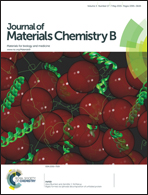Gold nanoparticle labeling based ICP-MS detection/measurement of bacteria, and their quantitative photothermal destruction†
Abstract
Bacteria such as Salmonella and E. coli present a great challenge in public health care in today's society. Protection of public safety against bacterial contamination and rapid diagnosis of infection require simple and fast assays for the detection and elimination of bacterial pathogens. After utilizing Salmonella DT104 as an example bacterial strain for our investigation, we report a rapid and sensitive assay for the qualitative and quantitative detection of bacteria by using antibody affinity binding, popcorn shaped gold nanoparticle (GNPOPs) labeling, surface enhanced Raman spectroscopy (SERS), and inductively coupled plasma mass spectrometry (ICP-MS) detection. For qualitative analysis, our assay can detect Salmonella within 10 min using Raman spectroscopy; for quantitative analysis, our assay has the ability to measure as few as 100 Salmonella DT104 in a 1 mL sample (100 CFU mL−1) within 40 min. Based on the quantitative detection, we investigated the quantitative destruction of Salmonella DT104, and the photothermal efficiency of the assay in order to reduce the amount of GNPOPs in the assay to ultimately eliminate any potential side effects/toxicity to the surrounding cells in vivo. Results suggest that our assay may serve as a promising candidate for qualitative and quantitative detection and elimination of a variety of bacterial pathogens.


 Please wait while we load your content...
Please wait while we load your content...